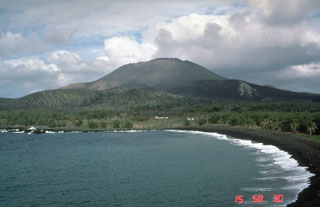Report on Pagan (United States) — February 1988
Scientific Event Alert Network Bulletin, vol. 13, no. 2 (February 1988)
Managing Editor: Lindsay McClelland.
Pagan (United States) Haze 300 km S attributed to Pagan eruption
Please cite this report as:
Global Volcanism Program, 1988. Report on Pagan (United States) (McClelland, L., ed.). Scientific Event Alert Network Bulletin, 13:2. Smithsonian Institution. https://doi.org/10.5479/si.GVP.SEAN198802-284170
Pagan
United States
18.13°N, 145.8°E; summit elev. 570 m
All times are local (unless otherwise noted)
Mid-February eruptive activity at Pagan may have been the source of an unusual haze that affected Saipan Island, 300 km to the S, but little information is yet available. A weather bulletin released 16 February at 2000 had reported an eruption on nearby Agrigan Island. However, a Civil Defense overflight detected no signs that an eruption had occurred there, and newspapers attributed the activity to Pagan. Satellite images on 16 February revealed no plume, despite clear weather. Seismographs that usually monitor Pagan's activity were being repaired.
Geological Summary. Pagan Island, the largest and one of the most active of the Mariana Islands volcanoes, consists of two stratovolcanoes connected by a narrow isthmus. Both North and South Pagan stratovolcanoes were constructed within calderas, 7 and 4 km in diameter, respectively. North Pagan at the NE end of the island rises above the flat floor of the northern caldera, which may have formed less than 1,000 years ago. South Pagan is a stratovolcano with an elongated summit containing four distinct craters. Almost all of the recorded eruptions, which date back to the 17th century, have originated from North Pagan. The largest eruption during historical time took place in 1981 and prompted the evacuation of the sparsely populated island.
Information Contacts: R. Walter, NOAA/NESDIS; J. Eldredge, Guam.

